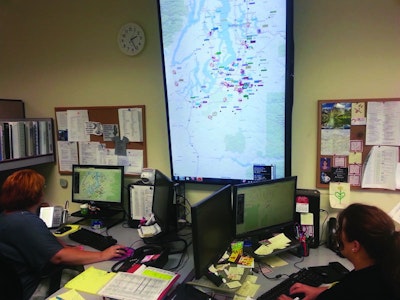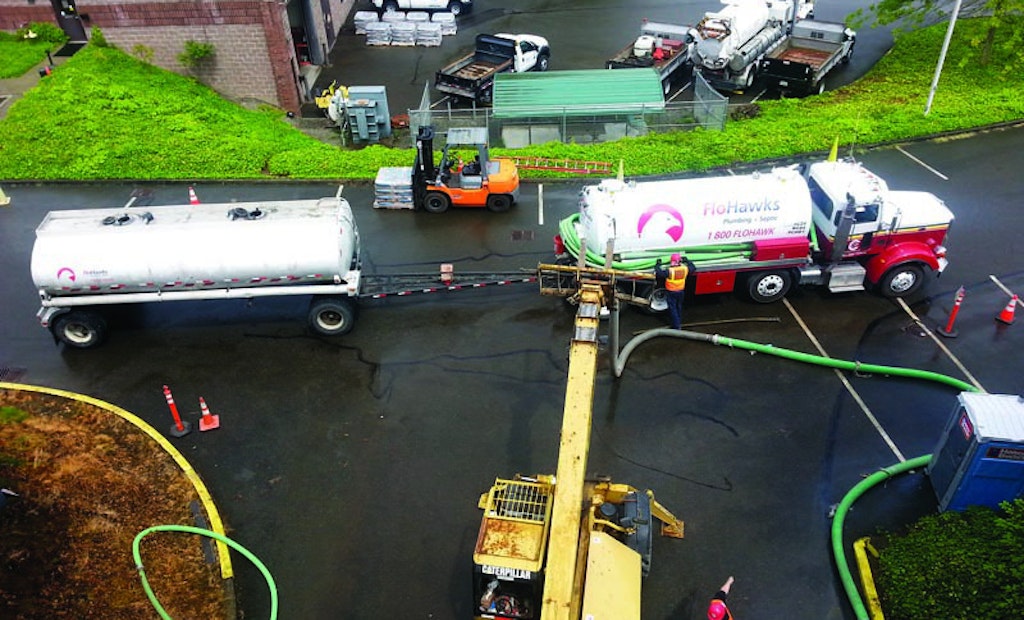Interested in Cleaning?
Get Cleaning articles, news and videos right in your inbox! Sign up now.
Cleaning + Get AlertsRunning a fleet of nearly 50 vehicles efficiently and cost-effectively poses a challenge for many companies. But officials at FloHawks Plumbing & Septic eliminated many of the hassles associated with that task by subscribing to a cloud-based fleet management system from US Fleet Tracking.
Along the way, the Puyallup, Wash.-based FloHawks (a division of Northwest Cascade Inc.) also increased profitability, employee accountability and customer service. In addition, the Global Positioning Satellite (GPS) fleet management system helped the company develop a flat-rate pricing structure; it now enables the firm to assess and adjust its pricing to accurately reflect actual costs, says J.R. Inman, vice president.
FloHawks provides sewer cleaning, septic tank pumping and residential plumbing and drain cleaning services in a five-county area in northwestern Washington. It runs 48 vehicles, including four combination vacuum trucks (made by Vactor Manufacturing and Vac-Con Inc.); 16 septic trucks (manufactured by Satellite Industries and Erickson Tank & Pump); and 28 Ford service trucks and vans equipped with Spartan Tool LLC drain cleaning machines and RIDGID SeeSnake pipeline inspection cameras.
More than a decade ago, FloHawks started using another GPS tracking system, for several reasons. First of all, the company wanted to know where service trucks were on weekends; on-call drivers would often take their vehicles home, and when service calls came in, dispatchers didn’t know the trucks’ locations.
“We owned a small number of vehicles at the time, so there wasn’t much equipment available on call,” Inman notes. “And if equipment wasn’t where it was supposed to be, we couldn’t service customers.”
Moreover, the company was developing a flat-rate pricing structure, and knowing exactly how much time employees were spending on jobs was integral to doing so.
Employee resistance to GPS tracking was minimal, Inman says, noting that only a few people quit after the company announced its plans to adopt a system. “For 98 percent of our employees, it wasn’t an issue,” he says.
Eventually, the company wanted more GPS features, so it switched to the cloud-based US Fleet system in June 2012 after scrutinizing various options at the Pumper & Cleaner Environmental Expo International.
“We wanted a service that could push our [dispatch] data onto a map on their website in real time … show where each truck is so we could dispatch more efficiently,” Inman says. “US Fleet said they could do it. Now we have a 70-inch monitor that everyone [in the dispatch center] can see at all times. When a dispatch is created, it pops up on the board in a minute or so – it’s pushed right onto the cloud. It even color codes the various types of service vehicles [vacuum trucks, service vans, etc.] for easier visual recognition.”
The GPS system yields benefits above and beyond more efficient dispatching. For example, it can quickly resolve any questions concerning the hours worked on a particular job. “If a customer wasn’t on site during the job and wants confirmation as to the hours invoiced, we can easily provide this data using the GPS,” Inman says.
The system also saves the company hundreds of dollars a day in fuel costs because the system can tell when a truck is idling – and wasting fuel. “Our bigger trucks can burn 1 1/4 to 2 1/2 gallons of fuel an hour while idling,” he notes. “Getting guys to shut down their trucks is huge.”
In addition, the system helps the company operate more cost-effectively by analyzing hours worked (which includes driving time) versus actual billable hours. In other words, more effective dispatching and employee monitoring has resulted in increased billable hours, Inman says.
“It might be just 4 or 5 percent more than before, but that amounts to a lot of money over the course of a year,” he says. “Even if you start saving just 1 percent at a time, it becomes a big number, and that all goes to the bottom line.”
Within a year after FloHawks switched to the US Fleet system, all divisions of Northwest Cascade did the same; that covers about 225 vehicles. Each under-dash GPS unit costs $150, and FloHawks pays $29.50 per vehicle per month for the Internet-based tracking, which is accessible via any Internet-capable device and updates automatically every 10 seconds. Moreover, there’s no long-term contract required, Inman adds.
“If you take it on a per truck or per guy basis, if we can get everyone to be one hour more efficient per month, the system pays for itself just in terms of reduced fuel and labor costs,” Inman points out. “And an hour isn’t a lot – it used to take guys half an hour to load their trucks. Needless to say, employees now get out of the yard faster [when they know they’re being tracked] because they don’t get paid until they leave the yard. The GPS units pay for themselves just about every morning.
“After 12 years of using GPS, I wouldn’t own a business like we’re in without it,” he concludes. “It keeps us honest and our drivers honest and helps give our customers the service they deserve.”







